Depression Among the Elderly
VerifiedAdded on 2022/12/28
|16
|4647
|1
AI Summary
This article discusses the prevalence, effects, and social determinants of depression among the elderly population. It explores the need for appropriate policies and collaboration with stakeholders to address this critical public health issue.
Contribute Materials
Your contribution can guide someone’s learning journey. Share your
documents today.
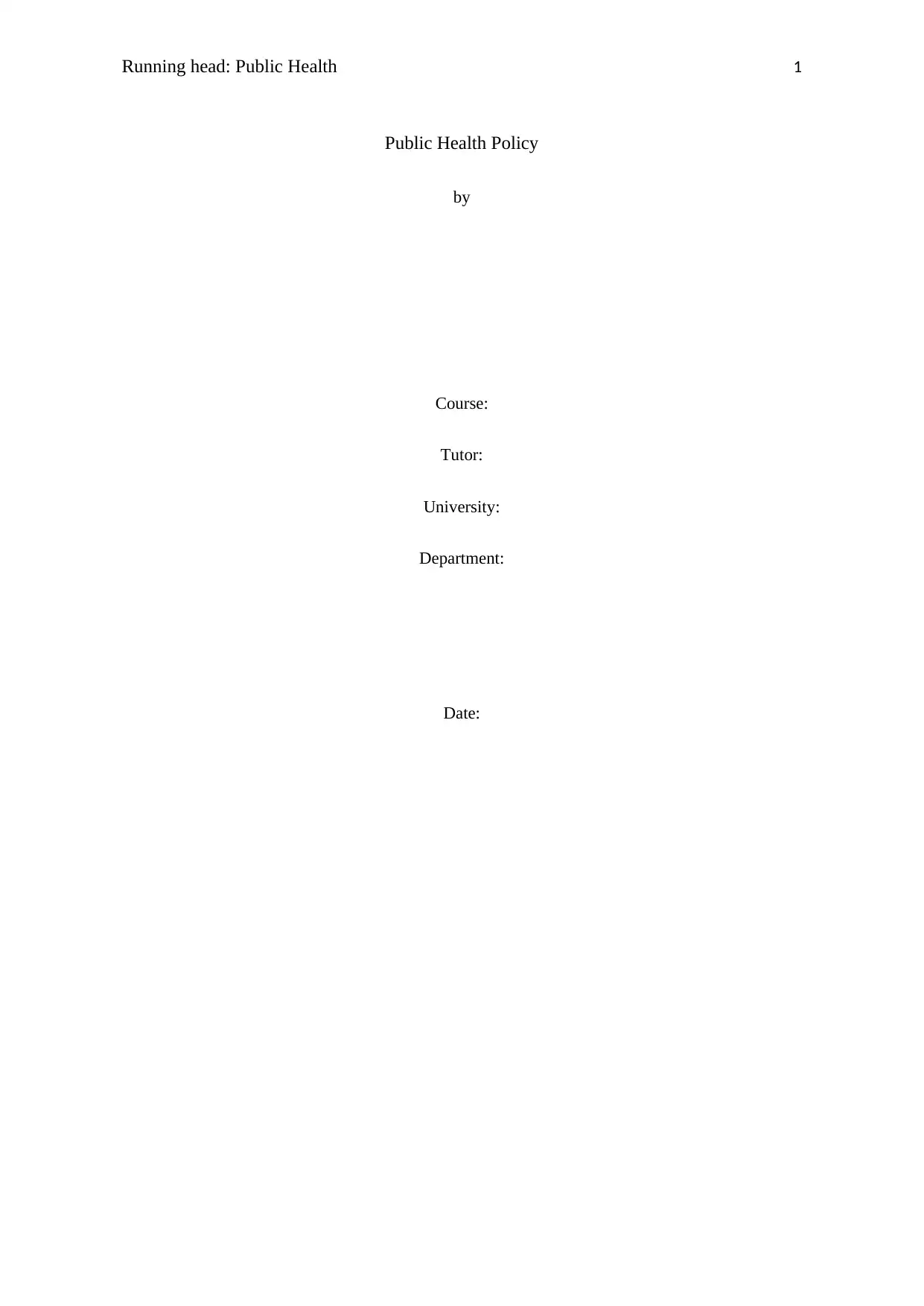
Running head: Public Health 1
Public Health Policy
by
Course:
Tutor:
University:
Department:
Date:
Public Health Policy
by
Course:
Tutor:
University:
Department:
Date:
Secure Best Marks with AI Grader
Need help grading? Try our AI Grader for instant feedback on your assignments.
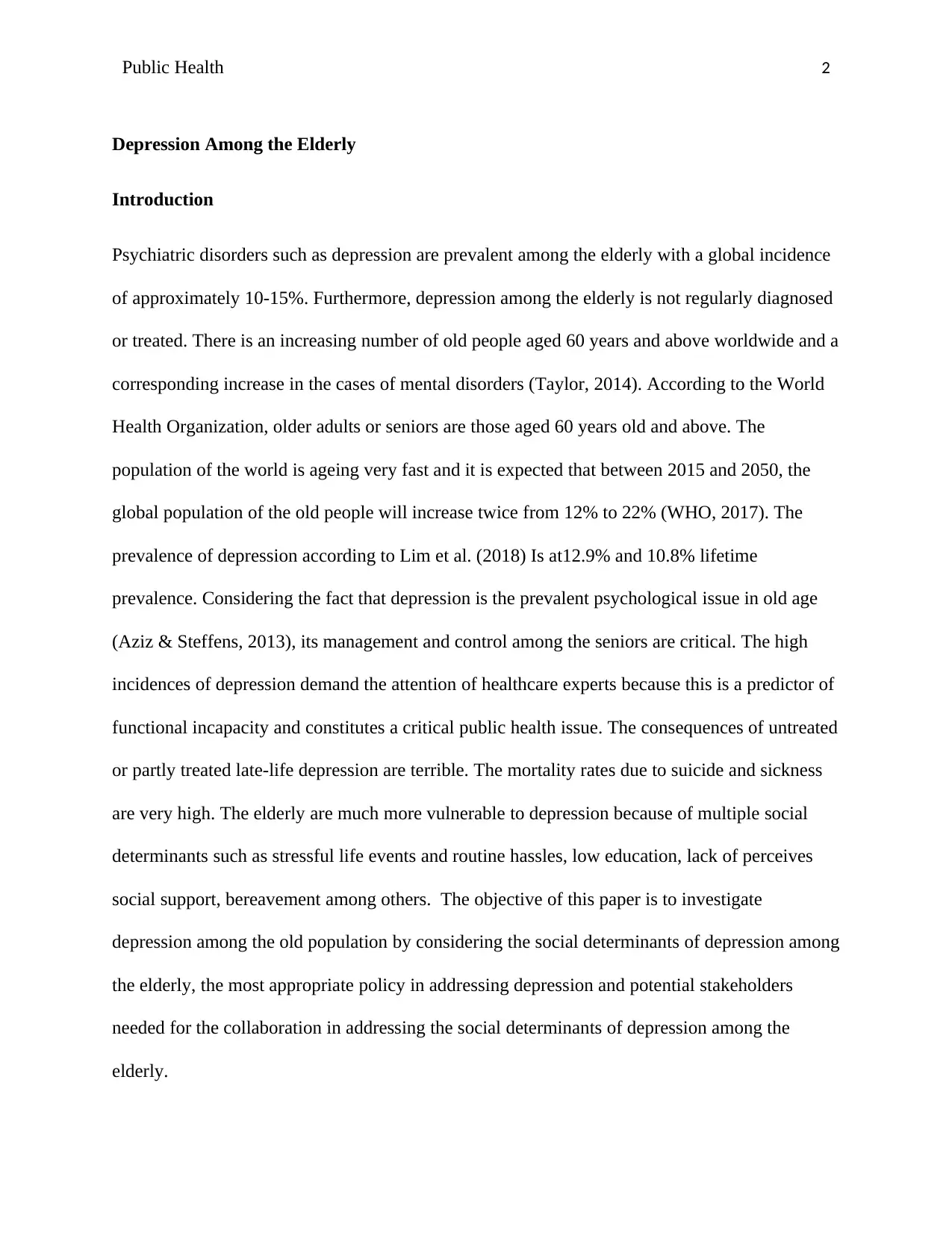
Public Health 2
Depression Among the Elderly
Introduction
Psychiatric disorders such as depression are prevalent among the elderly with a global incidence
of approximately 10-15%. Furthermore, depression among the elderly is not regularly diagnosed
or treated. There is an increasing number of old people aged 60 years and above worldwide and a
corresponding increase in the cases of mental disorders (Taylor, 2014). According to the World
Health Organization, older adults or seniors are those aged 60 years old and above. The
population of the world is ageing very fast and it is expected that between 2015 and 2050, the
global population of the old people will increase twice from 12% to 22% (WHO, 2017). The
prevalence of depression according to Lim et al. (2018) Is at12.9% and 10.8% lifetime
prevalence. Considering the fact that depression is the prevalent psychological issue in old age
(Aziz & Steffens, 2013), its management and control among the seniors are critical. The high
incidences of depression demand the attention of healthcare experts because this is a predictor of
functional incapacity and constitutes a critical public health issue. The consequences of untreated
or partly treated late-life depression are terrible. The mortality rates due to suicide and sickness
are very high. The elderly are much more vulnerable to depression because of multiple social
determinants such as stressful life events and routine hassles, low education, lack of perceives
social support, bereavement among others. The objective of this paper is to investigate
depression among the old population by considering the social determinants of depression among
the elderly, the most appropriate policy in addressing depression and potential stakeholders
needed for the collaboration in addressing the social determinants of depression among the
elderly.
Depression Among the Elderly
Introduction
Psychiatric disorders such as depression are prevalent among the elderly with a global incidence
of approximately 10-15%. Furthermore, depression among the elderly is not regularly diagnosed
or treated. There is an increasing number of old people aged 60 years and above worldwide and a
corresponding increase in the cases of mental disorders (Taylor, 2014). According to the World
Health Organization, older adults or seniors are those aged 60 years old and above. The
population of the world is ageing very fast and it is expected that between 2015 and 2050, the
global population of the old people will increase twice from 12% to 22% (WHO, 2017). The
prevalence of depression according to Lim et al. (2018) Is at12.9% and 10.8% lifetime
prevalence. Considering the fact that depression is the prevalent psychological issue in old age
(Aziz & Steffens, 2013), its management and control among the seniors are critical. The high
incidences of depression demand the attention of healthcare experts because this is a predictor of
functional incapacity and constitutes a critical public health issue. The consequences of untreated
or partly treated late-life depression are terrible. The mortality rates due to suicide and sickness
are very high. The elderly are much more vulnerable to depression because of multiple social
determinants such as stressful life events and routine hassles, low education, lack of perceives
social support, bereavement among others. The objective of this paper is to investigate
depression among the old population by considering the social determinants of depression among
the elderly, the most appropriate policy in addressing depression and potential stakeholders
needed for the collaboration in addressing the social determinants of depression among the
elderly.

Public Health 3
Description of Depression Among the Elderly
Depression has been defined as a common response to health issues and is usually an under-
diagnosed disorder among the senior’s population. Depression can be as a result of harm;
suffering from an initial loss, or individuals may require health care for somatic grumbles that
are the bodily expressions of depression (Brown & Harris, 2012). In other words, depression is a
state of sadness, worry and hopelessness, and with no interest for routine activities. According to
the World Health Organization, depression is a pathological state that is related to an emotional
state of loss or guilt and is caused by sadness, low self-esteem, lack of sleep or appetite,
exhaustion, and low concentration (WHO, 2017).
Depression in older population exists in multiple forms. The early onset depression (EOD) which
is a frequent illness beginning from earlier life. The late-onset depression (LOD) in which is a
disorder due to feelings subject to a general medical condition or due to medication or substance
use (Aziz & Steffens, 2013). Other researchers have distinguished different forms of depression
among the elderly on the basis of the symptoms and whether its mild, average and severe.
Individuals that have mild depression may not manifest physical signs of depression, but it can
be manifested verbally, through attitudes and reports from the friends and family. Moderate
depression is characteristic of involvement in normal activities but with less pleasure or
enjoyment and is caused by a lack of passion for life and low vitality. Severely depressed
individuals entertain suicidal thoughts and are likely to attempt suicide despite being less
energetic (Glaw, Kable, Hazelton, & Inder, 2017).
Prevalence of Depression among the Elderly Population
Description of Depression Among the Elderly
Depression has been defined as a common response to health issues and is usually an under-
diagnosed disorder among the senior’s population. Depression can be as a result of harm;
suffering from an initial loss, or individuals may require health care for somatic grumbles that
are the bodily expressions of depression (Brown & Harris, 2012). In other words, depression is a
state of sadness, worry and hopelessness, and with no interest for routine activities. According to
the World Health Organization, depression is a pathological state that is related to an emotional
state of loss or guilt and is caused by sadness, low self-esteem, lack of sleep or appetite,
exhaustion, and low concentration (WHO, 2017).
Depression in older population exists in multiple forms. The early onset depression (EOD) which
is a frequent illness beginning from earlier life. The late-onset depression (LOD) in which is a
disorder due to feelings subject to a general medical condition or due to medication or substance
use (Aziz & Steffens, 2013). Other researchers have distinguished different forms of depression
among the elderly on the basis of the symptoms and whether its mild, average and severe.
Individuals that have mild depression may not manifest physical signs of depression, but it can
be manifested verbally, through attitudes and reports from the friends and family. Moderate
depression is characteristic of involvement in normal activities but with less pleasure or
enjoyment and is caused by a lack of passion for life and low vitality. Severely depressed
individuals entertain suicidal thoughts and are likely to attempt suicide despite being less
energetic (Glaw, Kable, Hazelton, & Inder, 2017).
Prevalence of Depression among the Elderly Population
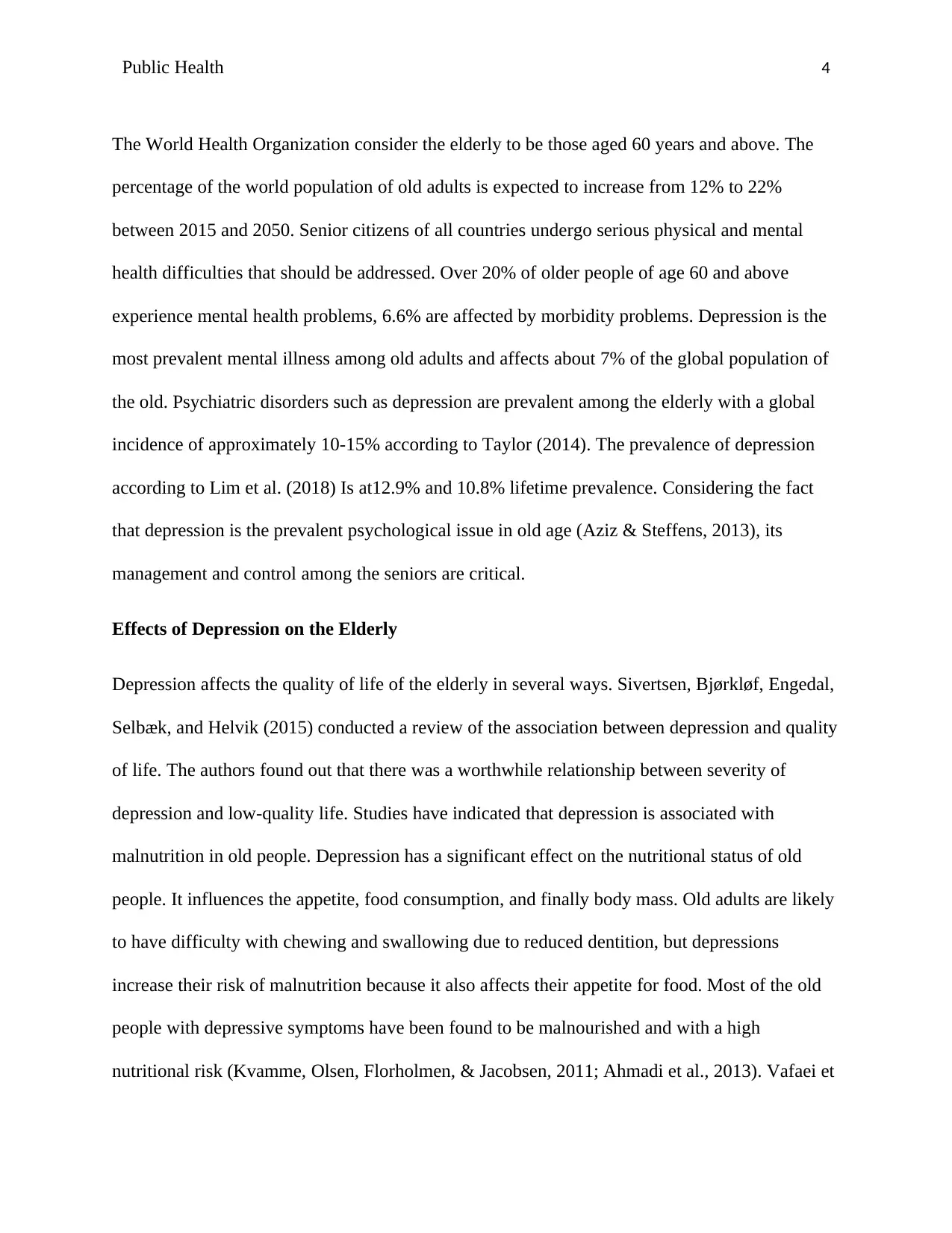
Public Health 4
The World Health Organization consider the elderly to be those aged 60 years and above. The
percentage of the world population of old adults is expected to increase from 12% to 22%
between 2015 and 2050. Senior citizens of all countries undergo serious physical and mental
health difficulties that should be addressed. Over 20% of older people of age 60 and above
experience mental health problems, 6.6% are affected by morbidity problems. Depression is the
most prevalent mental illness among old adults and affects about 7% of the global population of
the old. Psychiatric disorders such as depression are prevalent among the elderly with a global
incidence of approximately 10-15% according to Taylor (2014). The prevalence of depression
according to Lim et al. (2018) Is at12.9% and 10.8% lifetime prevalence. Considering the fact
that depression is the prevalent psychological issue in old age (Aziz & Steffens, 2013), its
management and control among the seniors are critical.
Effects of Depression on the Elderly
Depression affects the quality of life of the elderly in several ways. Sivertsen, Bjørkløf, Engedal,
Selbæk, and Helvik (2015) conducted a review of the association between depression and quality
of life. The authors found out that there was a worthwhile relationship between severity of
depression and low-quality life. Studies have indicated that depression is associated with
malnutrition in old people. Depression has a significant effect on the nutritional status of old
people. It influences the appetite, food consumption, and finally body mass. Old adults are likely
to have difficulty with chewing and swallowing due to reduced dentition, but depressions
increase their risk of malnutrition because it also affects their appetite for food. Most of the old
people with depressive symptoms have been found to be malnourished and with a high
nutritional risk (Kvamme, Olsen, Florholmen, & Jacobsen, 2011; Ahmadi et al., 2013). Vafaei et
The World Health Organization consider the elderly to be those aged 60 years and above. The
percentage of the world population of old adults is expected to increase from 12% to 22%
between 2015 and 2050. Senior citizens of all countries undergo serious physical and mental
health difficulties that should be addressed. Over 20% of older people of age 60 and above
experience mental health problems, 6.6% are affected by morbidity problems. Depression is the
most prevalent mental illness among old adults and affects about 7% of the global population of
the old. Psychiatric disorders such as depression are prevalent among the elderly with a global
incidence of approximately 10-15% according to Taylor (2014). The prevalence of depression
according to Lim et al. (2018) Is at12.9% and 10.8% lifetime prevalence. Considering the fact
that depression is the prevalent psychological issue in old age (Aziz & Steffens, 2013), its
management and control among the seniors are critical.
Effects of Depression on the Elderly
Depression affects the quality of life of the elderly in several ways. Sivertsen, Bjørkløf, Engedal,
Selbæk, and Helvik (2015) conducted a review of the association between depression and quality
of life. The authors found out that there was a worthwhile relationship between severity of
depression and low-quality life. Studies have indicated that depression is associated with
malnutrition in old people. Depression has a significant effect on the nutritional status of old
people. It influences the appetite, food consumption, and finally body mass. Old adults are likely
to have difficulty with chewing and swallowing due to reduced dentition, but depressions
increase their risk of malnutrition because it also affects their appetite for food. Most of the old
people with depressive symptoms have been found to be malnourished and with a high
nutritional risk (Kvamme, Olsen, Florholmen, & Jacobsen, 2011; Ahmadi et al., 2013). Vafaei et
Secure Best Marks with AI Grader
Need help grading? Try our AI Grader for instant feedback on your assignments.
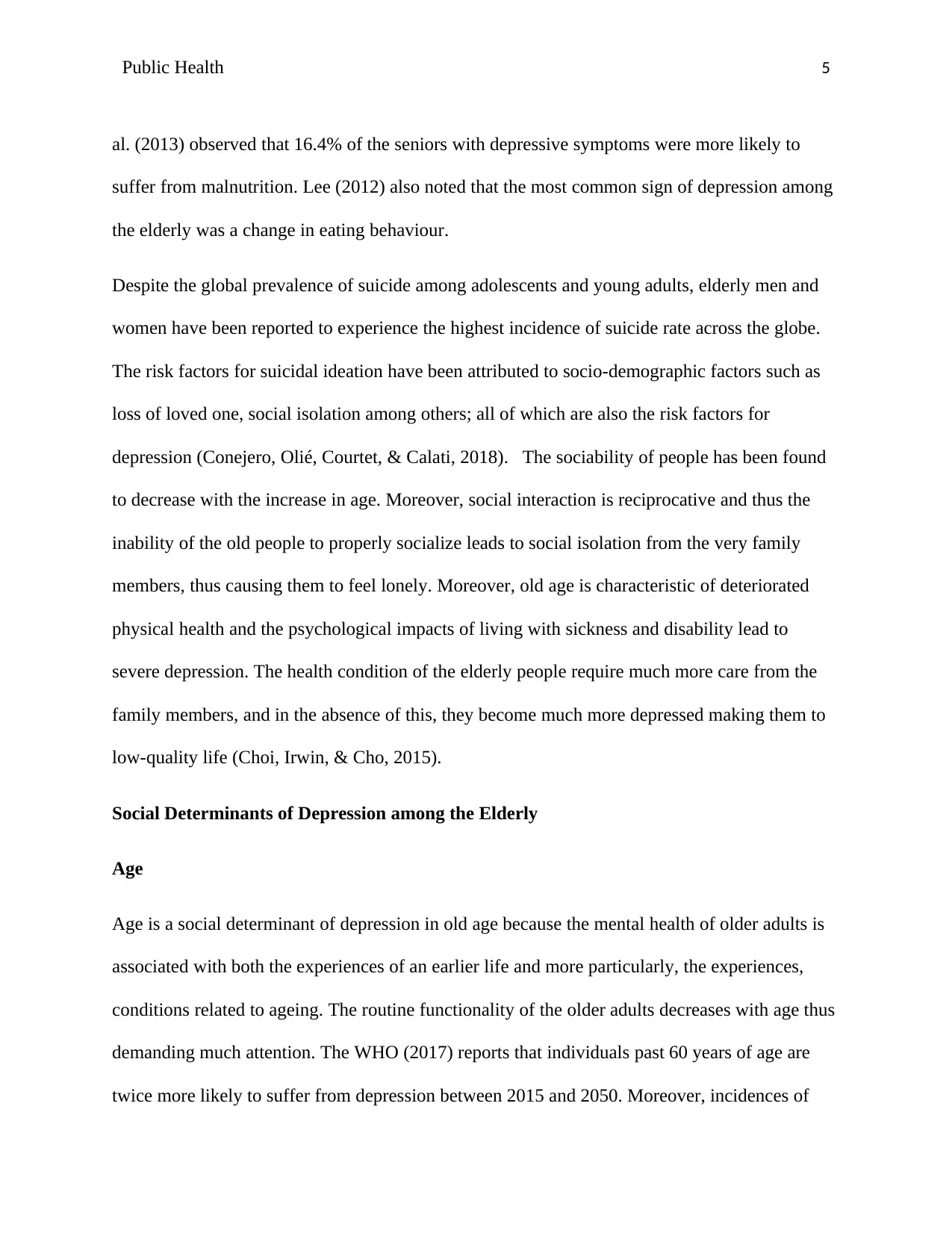
Public Health 5
al. (2013) observed that 16.4% of the seniors with depressive symptoms were more likely to
suffer from malnutrition. Lee (2012) also noted that the most common sign of depression among
the elderly was a change in eating behaviour.
Despite the global prevalence of suicide among adolescents and young adults, elderly men and
women have been reported to experience the highest incidence of suicide rate across the globe.
The risk factors for suicidal ideation have been attributed to socio-demographic factors such as
loss of loved one, social isolation among others; all of which are also the risk factors for
depression (Conejero, Olié, Courtet, & Calati, 2018). The sociability of people has been found
to decrease with the increase in age. Moreover, social interaction is reciprocative and thus the
inability of the old people to properly socialize leads to social isolation from the very family
members, thus causing them to feel lonely. Moreover, old age is characteristic of deteriorated
physical health and the psychological impacts of living with sickness and disability lead to
severe depression. The health condition of the elderly people require much more care from the
family members, and in the absence of this, they become much more depressed making them to
low-quality life (Choi, Irwin, & Cho, 2015).
Social Determinants of Depression among the Elderly
Age
Age is a social determinant of depression in old age because the mental health of older adults is
associated with both the experiences of an earlier life and more particularly, the experiences,
conditions related to ageing. The routine functionality of the older adults decreases with age thus
demanding much attention. The WHO (2017) reports that individuals past 60 years of age are
twice more likely to suffer from depression between 2015 and 2050. Moreover, incidences of
al. (2013) observed that 16.4% of the seniors with depressive symptoms were more likely to
suffer from malnutrition. Lee (2012) also noted that the most common sign of depression among
the elderly was a change in eating behaviour.
Despite the global prevalence of suicide among adolescents and young adults, elderly men and
women have been reported to experience the highest incidence of suicide rate across the globe.
The risk factors for suicidal ideation have been attributed to socio-demographic factors such as
loss of loved one, social isolation among others; all of which are also the risk factors for
depression (Conejero, Olié, Courtet, & Calati, 2018). The sociability of people has been found
to decrease with the increase in age. Moreover, social interaction is reciprocative and thus the
inability of the old people to properly socialize leads to social isolation from the very family
members, thus causing them to feel lonely. Moreover, old age is characteristic of deteriorated
physical health and the psychological impacts of living with sickness and disability lead to
severe depression. The health condition of the elderly people require much more care from the
family members, and in the absence of this, they become much more depressed making them to
low-quality life (Choi, Irwin, & Cho, 2015).
Social Determinants of Depression among the Elderly
Age
Age is a social determinant of depression in old age because the mental health of older adults is
associated with both the experiences of an earlier life and more particularly, the experiences,
conditions related to ageing. The routine functionality of the older adults decreases with age thus
demanding much attention. The WHO (2017) reports that individuals past 60 years of age are
twice more likely to suffer from depression between 2015 and 2050. Moreover, incidences of
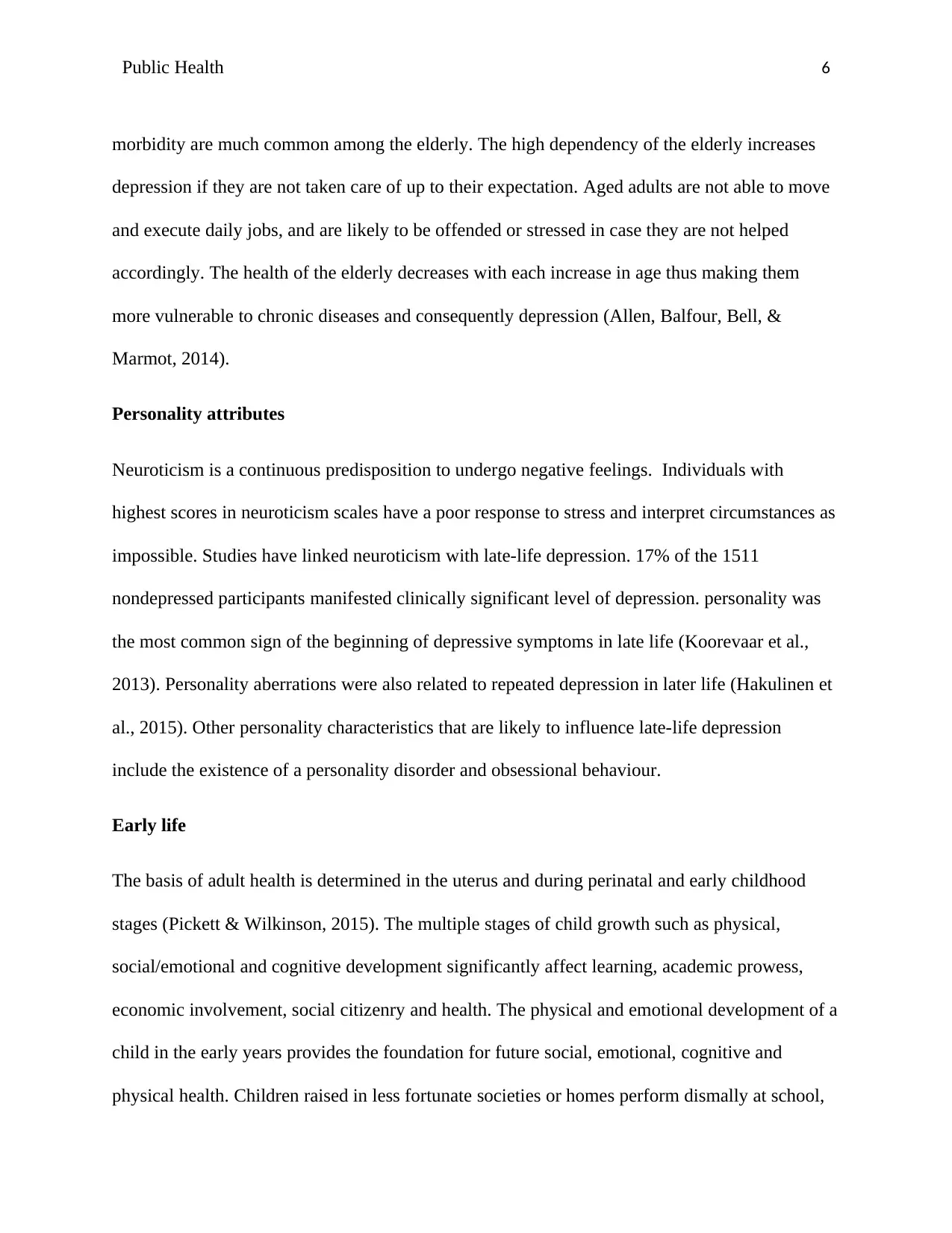
Public Health 6
morbidity are much common among the elderly. The high dependency of the elderly increases
depression if they are not taken care of up to their expectation. Aged adults are not able to move
and execute daily jobs, and are likely to be offended or stressed in case they are not helped
accordingly. The health of the elderly decreases with each increase in age thus making them
more vulnerable to chronic diseases and consequently depression (Allen, Balfour, Bell, &
Marmot, 2014).
Personality attributes
Neuroticism is a continuous predisposition to undergo negative feelings. Individuals with
highest scores in neuroticism scales have a poor response to stress and interpret circumstances as
impossible. Studies have linked neuroticism with late-life depression. 17% of the 1511
nondepressed participants manifested clinically significant level of depression. personality was
the most common sign of the beginning of depressive symptoms in late life (Koorevaar et al.,
2013). Personality aberrations were also related to repeated depression in later life (Hakulinen et
al., 2015). Other personality characteristics that are likely to influence late-life depression
include the existence of a personality disorder and obsessional behaviour.
Early life
The basis of adult health is determined in the uterus and during perinatal and early childhood
stages (Pickett & Wilkinson, 2015). The multiple stages of child growth such as physical,
social/emotional and cognitive development significantly affect learning, academic prowess,
economic involvement, social citizenry and health. The physical and emotional development of a
child in the early years provides the foundation for future social, emotional, cognitive and
physical health. Children raised in less fortunate societies or homes perform dismally at school,
morbidity are much common among the elderly. The high dependency of the elderly increases
depression if they are not taken care of up to their expectation. Aged adults are not able to move
and execute daily jobs, and are likely to be offended or stressed in case they are not helped
accordingly. The health of the elderly decreases with each increase in age thus making them
more vulnerable to chronic diseases and consequently depression (Allen, Balfour, Bell, &
Marmot, 2014).
Personality attributes
Neuroticism is a continuous predisposition to undergo negative feelings. Individuals with
highest scores in neuroticism scales have a poor response to stress and interpret circumstances as
impossible. Studies have linked neuroticism with late-life depression. 17% of the 1511
nondepressed participants manifested clinically significant level of depression. personality was
the most common sign of the beginning of depressive symptoms in late life (Koorevaar et al.,
2013). Personality aberrations were also related to repeated depression in later life (Hakulinen et
al., 2015). Other personality characteristics that are likely to influence late-life depression
include the existence of a personality disorder and obsessional behaviour.
Early life
The basis of adult health is determined in the uterus and during perinatal and early childhood
stages (Pickett & Wilkinson, 2015). The multiple stages of child growth such as physical,
social/emotional and cognitive development significantly affect learning, academic prowess,
economic involvement, social citizenry and health. The physical and emotional development of a
child in the early years provides the foundation for future social, emotional, cognitive and
physical health. Children raised in less fortunate societies or homes perform dismally at school,
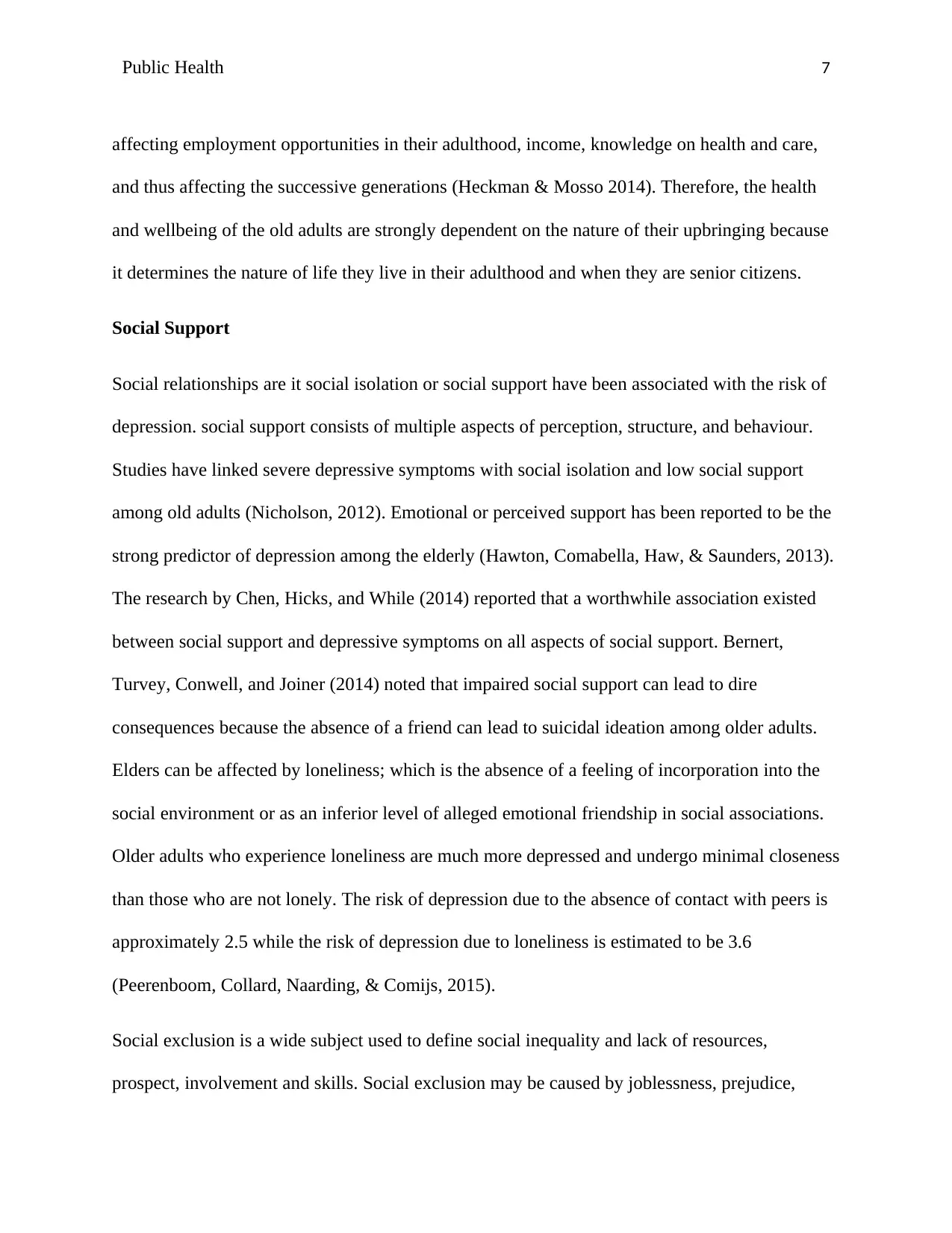
Public Health 7
affecting employment opportunities in their adulthood, income, knowledge on health and care,
and thus affecting the successive generations (Heckman & Mosso 2014). Therefore, the health
and wellbeing of the old adults are strongly dependent on the nature of their upbringing because
it determines the nature of life they live in their adulthood and when they are senior citizens.
Social Support
Social relationships are it social isolation or social support have been associated with the risk of
depression. social support consists of multiple aspects of perception, structure, and behaviour.
Studies have linked severe depressive symptoms with social isolation and low social support
among old adults (Nicholson, 2012). Emotional or perceived support has been reported to be the
strong predictor of depression among the elderly (Hawton, Comabella, Haw, & Saunders, 2013).
The research by Chen, Hicks, and While (2014) reported that a worthwhile association existed
between social support and depressive symptoms on all aspects of social support. Bernert,
Turvey, Conwell, and Joiner (2014) noted that impaired social support can lead to dire
consequences because the absence of a friend can lead to suicidal ideation among older adults.
Elders can be affected by loneliness; which is the absence of a feeling of incorporation into the
social environment or as an inferior level of alleged emotional friendship in social associations.
Older adults who experience loneliness are much more depressed and undergo minimal closeness
than those who are not lonely. The risk of depression due to the absence of contact with peers is
approximately 2.5 while the risk of depression due to loneliness is estimated to be 3.6
(Peerenboom, Collard, Naarding, & Comijs, 2015).
Social exclusion is a wide subject used to define social inequality and lack of resources,
prospect, involvement and skills. Social exclusion may be caused by joblessness, prejudice,
affecting employment opportunities in their adulthood, income, knowledge on health and care,
and thus affecting the successive generations (Heckman & Mosso 2014). Therefore, the health
and wellbeing of the old adults are strongly dependent on the nature of their upbringing because
it determines the nature of life they live in their adulthood and when they are senior citizens.
Social Support
Social relationships are it social isolation or social support have been associated with the risk of
depression. social support consists of multiple aspects of perception, structure, and behaviour.
Studies have linked severe depressive symptoms with social isolation and low social support
among old adults (Nicholson, 2012). Emotional or perceived support has been reported to be the
strong predictor of depression among the elderly (Hawton, Comabella, Haw, & Saunders, 2013).
The research by Chen, Hicks, and While (2014) reported that a worthwhile association existed
between social support and depressive symptoms on all aspects of social support. Bernert,
Turvey, Conwell, and Joiner (2014) noted that impaired social support can lead to dire
consequences because the absence of a friend can lead to suicidal ideation among older adults.
Elders can be affected by loneliness; which is the absence of a feeling of incorporation into the
social environment or as an inferior level of alleged emotional friendship in social associations.
Older adults who experience loneliness are much more depressed and undergo minimal closeness
than those who are not lonely. The risk of depression due to the absence of contact with peers is
approximately 2.5 while the risk of depression due to loneliness is estimated to be 3.6
(Peerenboom, Collard, Naarding, & Comijs, 2015).
Social exclusion is a wide subject used to define social inequality and lack of resources,
prospect, involvement and skills. Social exclusion may be caused by joblessness, prejudice,
Paraphrase This Document
Need a fresh take? Get an instant paraphrase of this document with our AI Paraphraser
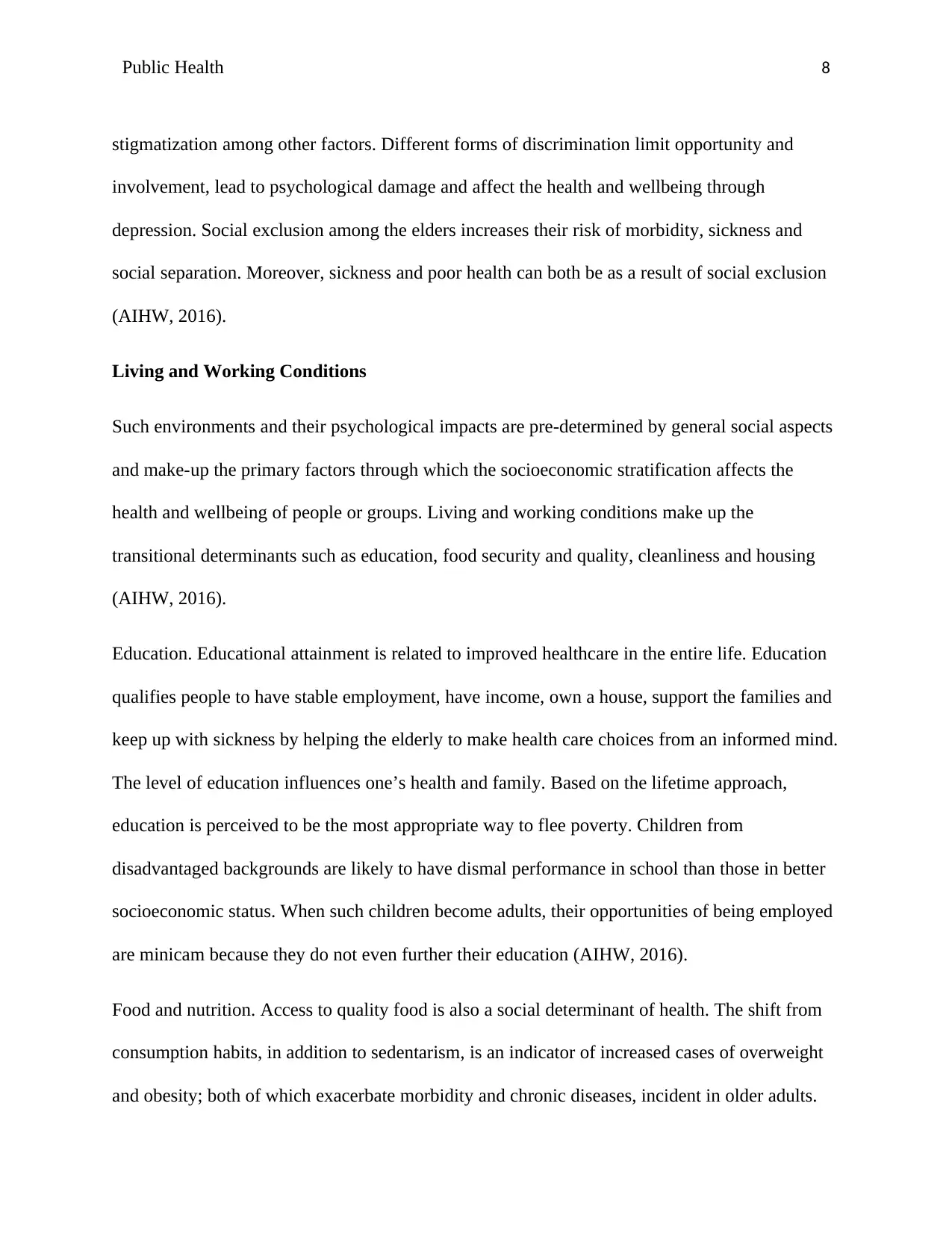
Public Health 8
stigmatization among other factors. Different forms of discrimination limit opportunity and
involvement, lead to psychological damage and affect the health and wellbeing through
depression. Social exclusion among the elders increases their risk of morbidity, sickness and
social separation. Moreover, sickness and poor health can both be as a result of social exclusion
(AIHW, 2016).
Living and Working Conditions
Such environments and their psychological impacts are pre-determined by general social aspects
and make-up the primary factors through which the socioeconomic stratification affects the
health and wellbeing of people or groups. Living and working conditions make up the
transitional determinants such as education, food security and quality, cleanliness and housing
(AIHW, 2016).
Education. Educational attainment is related to improved healthcare in the entire life. Education
qualifies people to have stable employment, have income, own a house, support the families and
keep up with sickness by helping the elderly to make health care choices from an informed mind.
The level of education influences one’s health and family. Based on the lifetime approach,
education is perceived to be the most appropriate way to flee poverty. Children from
disadvantaged backgrounds are likely to have dismal performance in school than those in better
socioeconomic status. When such children become adults, their opportunities of being employed
are minicam because they do not even further their education (AIHW, 2016).
Food and nutrition. Access to quality food is also a social determinant of health. The shift from
consumption habits, in addition to sedentarism, is an indicator of increased cases of overweight
and obesity; both of which exacerbate morbidity and chronic diseases, incident in older adults.
stigmatization among other factors. Different forms of discrimination limit opportunity and
involvement, lead to psychological damage and affect the health and wellbeing through
depression. Social exclusion among the elders increases their risk of morbidity, sickness and
social separation. Moreover, sickness and poor health can both be as a result of social exclusion
(AIHW, 2016).
Living and Working Conditions
Such environments and their psychological impacts are pre-determined by general social aspects
and make-up the primary factors through which the socioeconomic stratification affects the
health and wellbeing of people or groups. Living and working conditions make up the
transitional determinants such as education, food security and quality, cleanliness and housing
(AIHW, 2016).
Education. Educational attainment is related to improved healthcare in the entire life. Education
qualifies people to have stable employment, have income, own a house, support the families and
keep up with sickness by helping the elderly to make health care choices from an informed mind.
The level of education influences one’s health and family. Based on the lifetime approach,
education is perceived to be the most appropriate way to flee poverty. Children from
disadvantaged backgrounds are likely to have dismal performance in school than those in better
socioeconomic status. When such children become adults, their opportunities of being employed
are minicam because they do not even further their education (AIHW, 2016).
Food and nutrition. Access to quality food is also a social determinant of health. The shift from
consumption habits, in addition to sedentarism, is an indicator of increased cases of overweight
and obesity; both of which exacerbate morbidity and chronic diseases, incident in older adults.
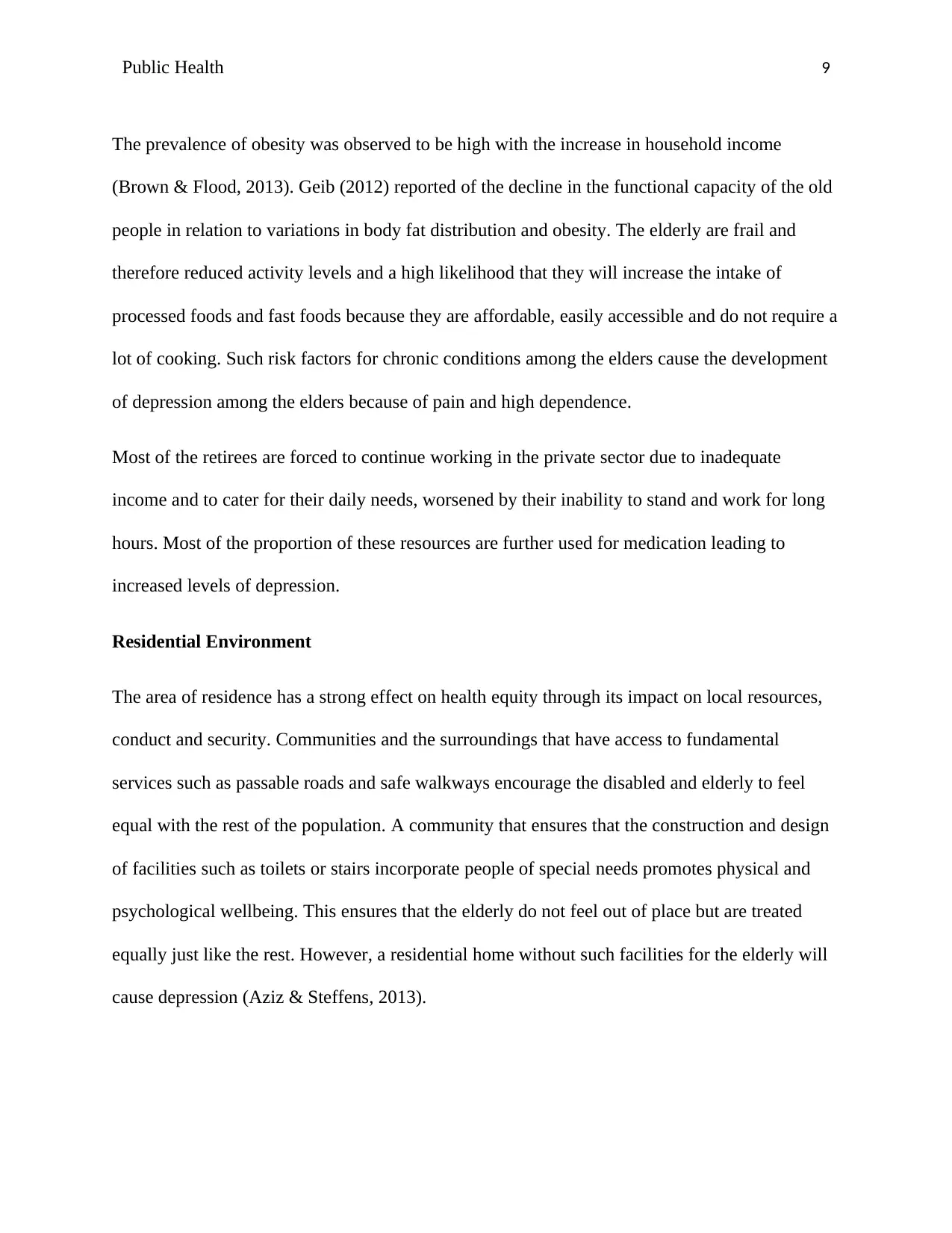
Public Health 9
The prevalence of obesity was observed to be high with the increase in household income
(Brown & Flood, 2013). Geib (2012) reported of the decline in the functional capacity of the old
people in relation to variations in body fat distribution and obesity. The elderly are frail and
therefore reduced activity levels and a high likelihood that they will increase the intake of
processed foods and fast foods because they are affordable, easily accessible and do not require a
lot of cooking. Such risk factors for chronic conditions among the elders cause the development
of depression among the elders because of pain and high dependence.
Most of the retirees are forced to continue working in the private sector due to inadequate
income and to cater for their daily needs, worsened by their inability to stand and work for long
hours. Most of the proportion of these resources are further used for medication leading to
increased levels of depression.
Residential Environment
The area of residence has a strong effect on health equity through its impact on local resources,
conduct and security. Communities and the surroundings that have access to fundamental
services such as passable roads and safe walkways encourage the disabled and elderly to feel
equal with the rest of the population. A community that ensures that the construction and design
of facilities such as toilets or stairs incorporate people of special needs promotes physical and
psychological wellbeing. This ensures that the elderly do not feel out of place but are treated
equally just like the rest. However, a residential home without such facilities for the elderly will
cause depression (Aziz & Steffens, 2013).
The prevalence of obesity was observed to be high with the increase in household income
(Brown & Flood, 2013). Geib (2012) reported of the decline in the functional capacity of the old
people in relation to variations in body fat distribution and obesity. The elderly are frail and
therefore reduced activity levels and a high likelihood that they will increase the intake of
processed foods and fast foods because they are affordable, easily accessible and do not require a
lot of cooking. Such risk factors for chronic conditions among the elders cause the development
of depression among the elders because of pain and high dependence.
Most of the retirees are forced to continue working in the private sector due to inadequate
income and to cater for their daily needs, worsened by their inability to stand and work for long
hours. Most of the proportion of these resources are further used for medication leading to
increased levels of depression.
Residential Environment
The area of residence has a strong effect on health equity through its impact on local resources,
conduct and security. Communities and the surroundings that have access to fundamental
services such as passable roads and safe walkways encourage the disabled and elderly to feel
equal with the rest of the population. A community that ensures that the construction and design
of facilities such as toilets or stairs incorporate people of special needs promotes physical and
psychological wellbeing. This ensures that the elderly do not feel out of place but are treated
equally just like the rest. However, a residential home without such facilities for the elderly will
cause depression (Aziz & Steffens, 2013).
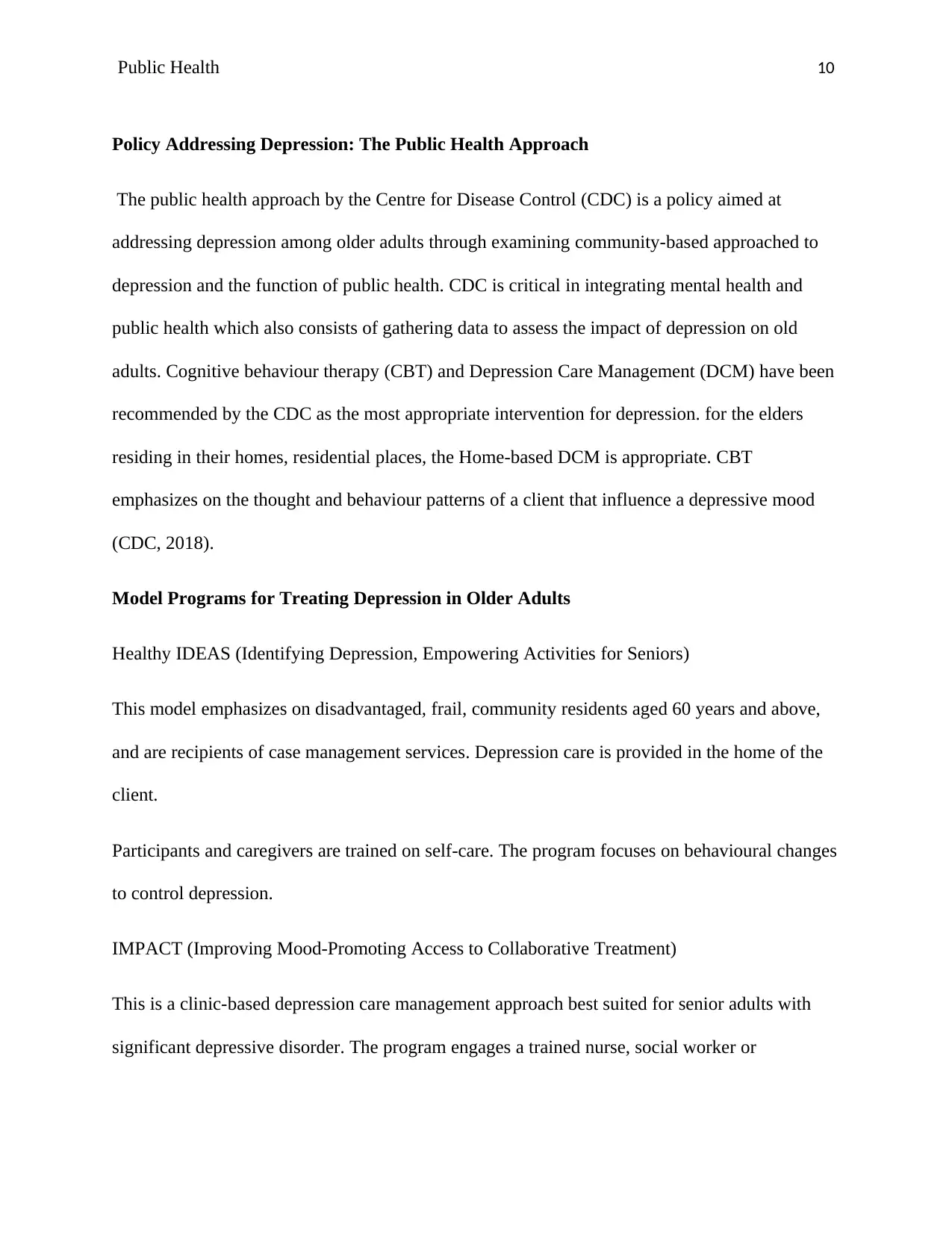
Public Health 10
Policy Addressing Depression: The Public Health Approach
The public health approach by the Centre for Disease Control (CDC) is a policy aimed at
addressing depression among older adults through examining community-based approached to
depression and the function of public health. CDC is critical in integrating mental health and
public health which also consists of gathering data to assess the impact of depression on old
adults. Cognitive behaviour therapy (CBT) and Depression Care Management (DCM) have been
recommended by the CDC as the most appropriate intervention for depression. for the elders
residing in their homes, residential places, the Home-based DCM is appropriate. CBT
emphasizes on the thought and behaviour patterns of a client that influence a depressive mood
(CDC, 2018).
Model Programs for Treating Depression in Older Adults
Healthy IDEAS (Identifying Depression, Empowering Activities for Seniors)
This model emphasizes on disadvantaged, frail, community residents aged 60 years and above,
and are recipients of case management services. Depression care is provided in the home of the
client.
Participants and caregivers are trained on self-care. The program focuses on behavioural changes
to control depression.
IMPACT (Improving Mood-Promoting Access to Collaborative Treatment)
This is a clinic-based depression care management approach best suited for senior adults with
significant depressive disorder. The program engages a trained nurse, social worker or
Policy Addressing Depression: The Public Health Approach
The public health approach by the Centre for Disease Control (CDC) is a policy aimed at
addressing depression among older adults through examining community-based approached to
depression and the function of public health. CDC is critical in integrating mental health and
public health which also consists of gathering data to assess the impact of depression on old
adults. Cognitive behaviour therapy (CBT) and Depression Care Management (DCM) have been
recommended by the CDC as the most appropriate intervention for depression. for the elders
residing in their homes, residential places, the Home-based DCM is appropriate. CBT
emphasizes on the thought and behaviour patterns of a client that influence a depressive mood
(CDC, 2018).
Model Programs for Treating Depression in Older Adults
Healthy IDEAS (Identifying Depression, Empowering Activities for Seniors)
This model emphasizes on disadvantaged, frail, community residents aged 60 years and above,
and are recipients of case management services. Depression care is provided in the home of the
client.
Participants and caregivers are trained on self-care. The program focuses on behavioural changes
to control depression.
IMPACT (Improving Mood-Promoting Access to Collaborative Treatment)
This is a clinic-based depression care management approach best suited for senior adults with
significant depressive disorder. The program engages a trained nurse, social worker or
Secure Best Marks with AI Grader
Need help grading? Try our AI Grader for instant feedback on your assignments.
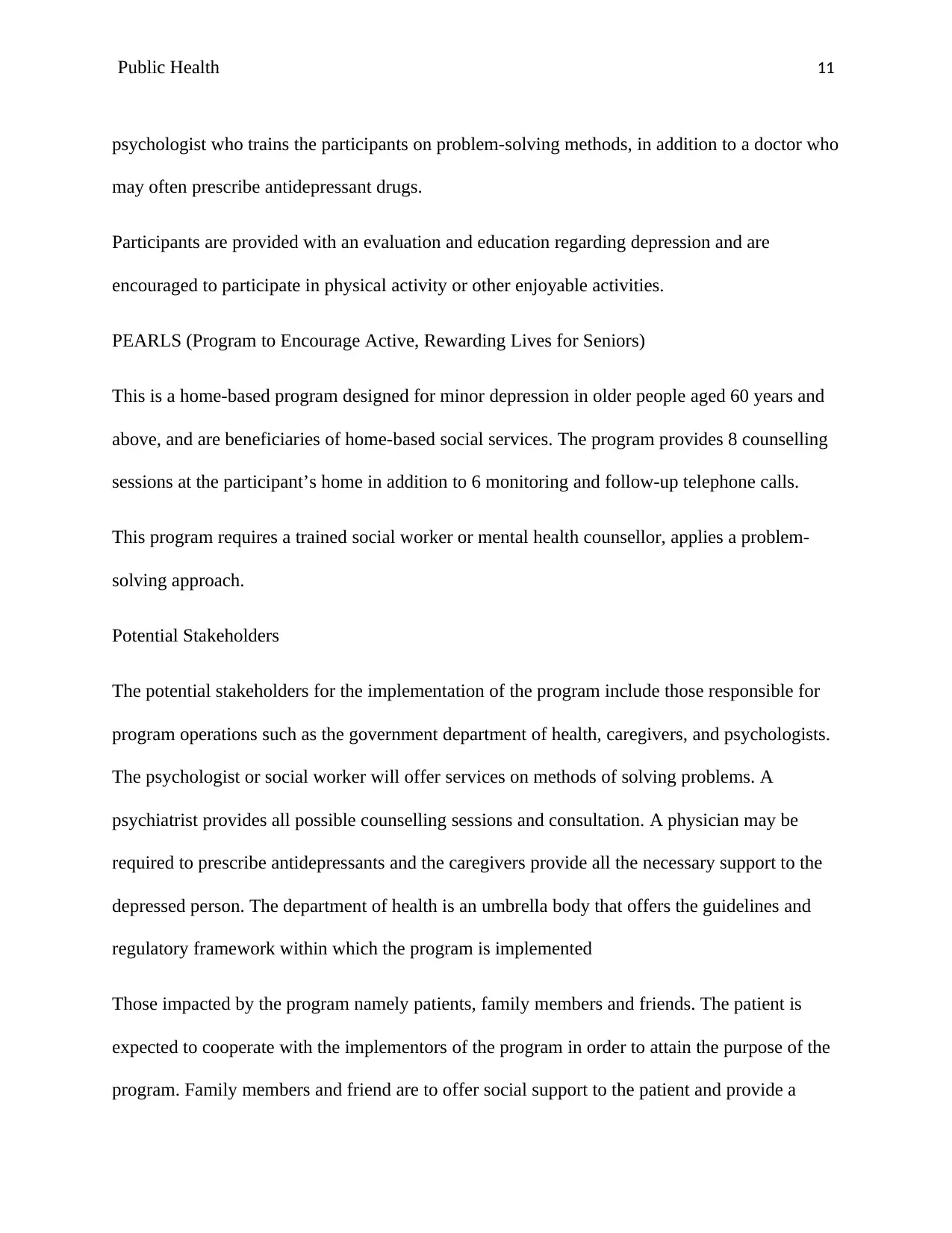
Public Health 11
psychologist who trains the participants on problem-solving methods, in addition to a doctor who
may often prescribe antidepressant drugs.
Participants are provided with an evaluation and education regarding depression and are
encouraged to participate in physical activity or other enjoyable activities.
PEARLS (Program to Encourage Active, Rewarding Lives for Seniors)
This is a home-based program designed for minor depression in older people aged 60 years and
above, and are beneficiaries of home-based social services. The program provides 8 counselling
sessions at the participant’s home in addition to 6 monitoring and follow-up telephone calls.
This program requires a trained social worker or mental health counsellor, applies a problem-
solving approach.
Potential Stakeholders
The potential stakeholders for the implementation of the program include those responsible for
program operations such as the government department of health, caregivers, and psychologists.
The psychologist or social worker will offer services on methods of solving problems. A
psychiatrist provides all possible counselling sessions and consultation. A physician may be
required to prescribe antidepressants and the caregivers provide all the necessary support to the
depressed person. The department of health is an umbrella body that offers the guidelines and
regulatory framework within which the program is implemented
Those impacted by the program namely patients, family members and friends. The patient is
expected to cooperate with the implementors of the program in order to attain the purpose of the
program. Family members and friend are to offer social support to the patient and provide a
psychologist who trains the participants on problem-solving methods, in addition to a doctor who
may often prescribe antidepressant drugs.
Participants are provided with an evaluation and education regarding depression and are
encouraged to participate in physical activity or other enjoyable activities.
PEARLS (Program to Encourage Active, Rewarding Lives for Seniors)
This is a home-based program designed for minor depression in older people aged 60 years and
above, and are beneficiaries of home-based social services. The program provides 8 counselling
sessions at the participant’s home in addition to 6 monitoring and follow-up telephone calls.
This program requires a trained social worker or mental health counsellor, applies a problem-
solving approach.
Potential Stakeholders
The potential stakeholders for the implementation of the program include those responsible for
program operations such as the government department of health, caregivers, and psychologists.
The psychologist or social worker will offer services on methods of solving problems. A
psychiatrist provides all possible counselling sessions and consultation. A physician may be
required to prescribe antidepressants and the caregivers provide all the necessary support to the
depressed person. The department of health is an umbrella body that offers the guidelines and
regulatory framework within which the program is implemented
Those impacted by the program namely patients, family members and friends. The patient is
expected to cooperate with the implementors of the program in order to attain the purpose of the
program. Family members and friend are to offer social support to the patient and provide a
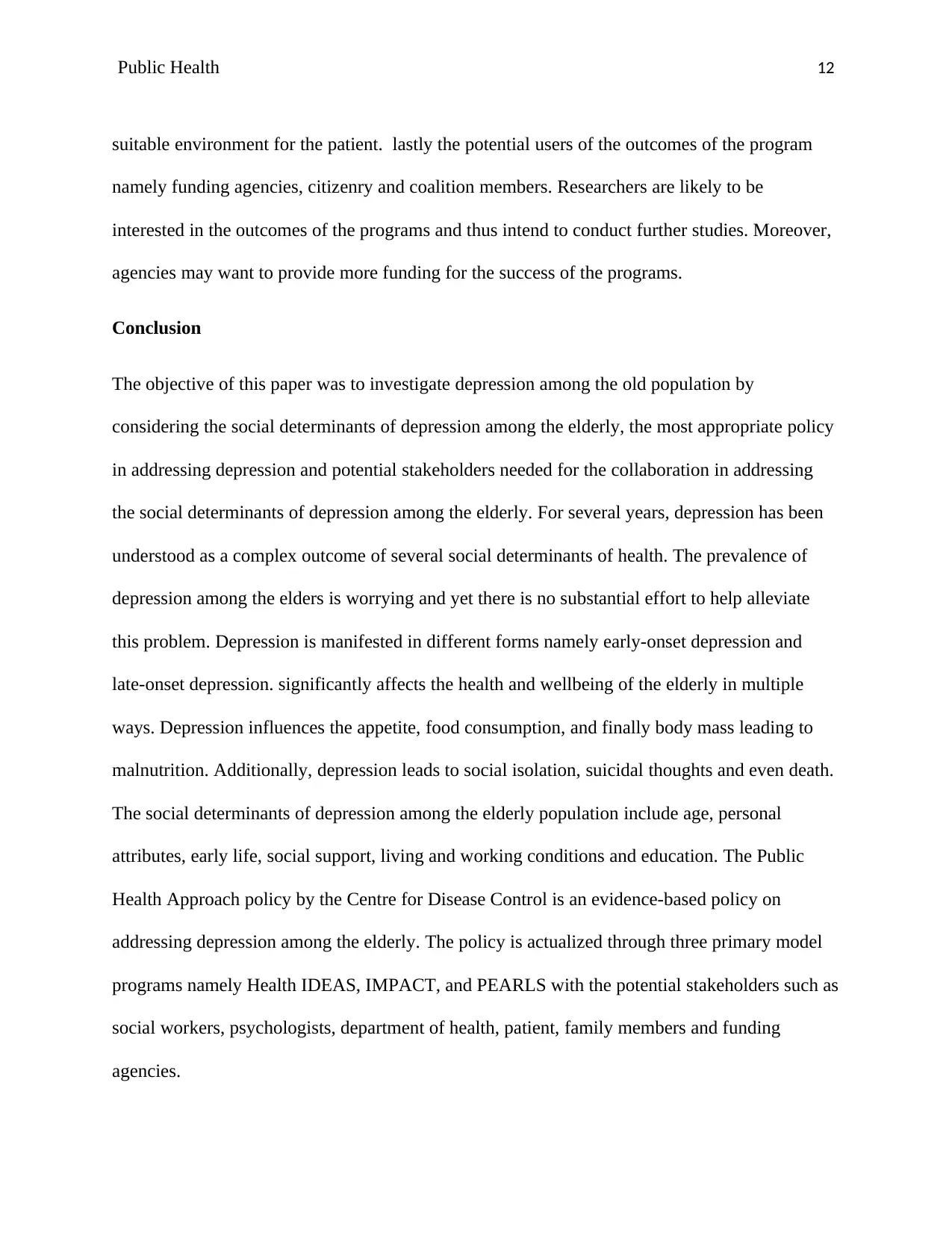
Public Health 12
suitable environment for the patient. lastly the potential users of the outcomes of the program
namely funding agencies, citizenry and coalition members. Researchers are likely to be
interested in the outcomes of the programs and thus intend to conduct further studies. Moreover,
agencies may want to provide more funding for the success of the programs.
Conclusion
The objective of this paper was to investigate depression among the old population by
considering the social determinants of depression among the elderly, the most appropriate policy
in addressing depression and potential stakeholders needed for the collaboration in addressing
the social determinants of depression among the elderly. For several years, depression has been
understood as a complex outcome of several social determinants of health. The prevalence of
depression among the elders is worrying and yet there is no substantial effort to help alleviate
this problem. Depression is manifested in different forms namely early-onset depression and
late-onset depression. significantly affects the health and wellbeing of the elderly in multiple
ways. Depression influences the appetite, food consumption, and finally body mass leading to
malnutrition. Additionally, depression leads to social isolation, suicidal thoughts and even death.
The social determinants of depression among the elderly population include age, personal
attributes, early life, social support, living and working conditions and education. The Public
Health Approach policy by the Centre for Disease Control is an evidence-based policy on
addressing depression among the elderly. The policy is actualized through three primary model
programs namely Health IDEAS, IMPACT, and PEARLS with the potential stakeholders such as
social workers, psychologists, department of health, patient, family members and funding
agencies.
suitable environment for the patient. lastly the potential users of the outcomes of the program
namely funding agencies, citizenry and coalition members. Researchers are likely to be
interested in the outcomes of the programs and thus intend to conduct further studies. Moreover,
agencies may want to provide more funding for the success of the programs.
Conclusion
The objective of this paper was to investigate depression among the old population by
considering the social determinants of depression among the elderly, the most appropriate policy
in addressing depression and potential stakeholders needed for the collaboration in addressing
the social determinants of depression among the elderly. For several years, depression has been
understood as a complex outcome of several social determinants of health. The prevalence of
depression among the elders is worrying and yet there is no substantial effort to help alleviate
this problem. Depression is manifested in different forms namely early-onset depression and
late-onset depression. significantly affects the health and wellbeing of the elderly in multiple
ways. Depression influences the appetite, food consumption, and finally body mass leading to
malnutrition. Additionally, depression leads to social isolation, suicidal thoughts and even death.
The social determinants of depression among the elderly population include age, personal
attributes, early life, social support, living and working conditions and education. The Public
Health Approach policy by the Centre for Disease Control is an evidence-based policy on
addressing depression among the elderly. The policy is actualized through three primary model
programs namely Health IDEAS, IMPACT, and PEARLS with the potential stakeholders such as
social workers, psychologists, department of health, patient, family members and funding
agencies.
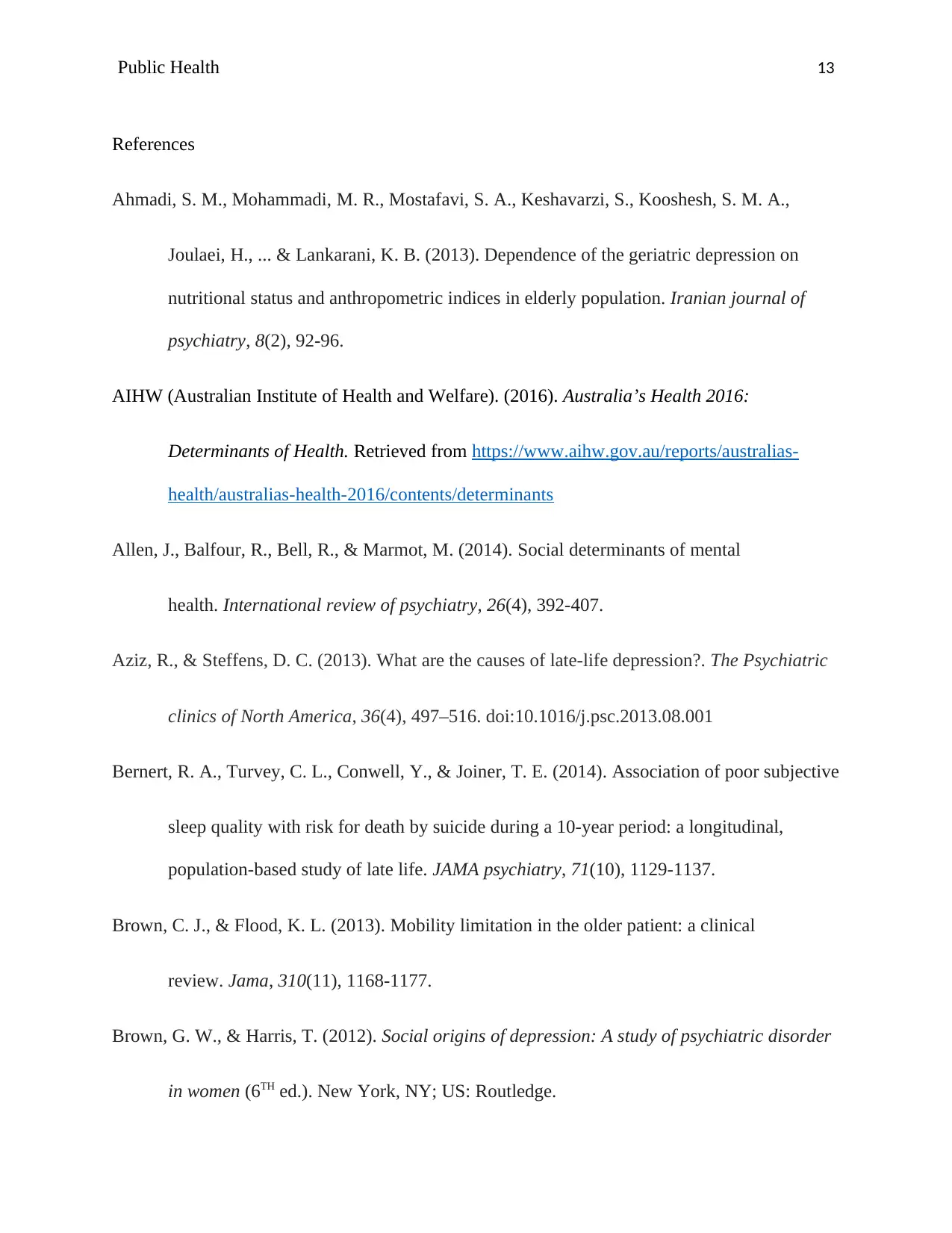
Public Health 13
References
Ahmadi, S. M., Mohammadi, M. R., Mostafavi, S. A., Keshavarzi, S., Kooshesh, S. M. A.,
Joulaei, H., ... & Lankarani, K. B. (2013). Dependence of the geriatric depression on
nutritional status and anthropometric indices in elderly population. Iranian journal of
psychiatry, 8(2), 92-96.
AIHW (Australian Institute of Health and Welfare). (2016). Australia’s Health 2016:
Determinants of Health. Retrieved from https://www.aihw.gov.au/reports/australias-
health/australias-health-2016/contents/determinants
Allen, J., Balfour, R., Bell, R., & Marmot, M. (2014). Social determinants of mental
health. International review of psychiatry, 26(4), 392-407.
Aziz, R., & Steffens, D. C. (2013). What are the causes of late-life depression?. The Psychiatric
clinics of North America, 36(4), 497–516. doi:10.1016/j.psc.2013.08.001
Bernert, R. A., Turvey, C. L., Conwell, Y., & Joiner, T. E. (2014). Association of poor subjective
sleep quality with risk for death by suicide during a 10-year period: a longitudinal,
population-based study of late life. JAMA psychiatry, 71(10), 1129-1137.
Brown, C. J., & Flood, K. L. (2013). Mobility limitation in the older patient: a clinical
review. Jama, 310(11), 1168-1177.
Brown, G. W., & Harris, T. (2012). Social origins of depression: A study of psychiatric disorder
in women (6TH ed.). New York, NY; US: Routledge.
References
Ahmadi, S. M., Mohammadi, M. R., Mostafavi, S. A., Keshavarzi, S., Kooshesh, S. M. A.,
Joulaei, H., ... & Lankarani, K. B. (2013). Dependence of the geriatric depression on
nutritional status and anthropometric indices in elderly population. Iranian journal of
psychiatry, 8(2), 92-96.
AIHW (Australian Institute of Health and Welfare). (2016). Australia’s Health 2016:
Determinants of Health. Retrieved from https://www.aihw.gov.au/reports/australias-
health/australias-health-2016/contents/determinants
Allen, J., Balfour, R., Bell, R., & Marmot, M. (2014). Social determinants of mental
health. International review of psychiatry, 26(4), 392-407.
Aziz, R., & Steffens, D. C. (2013). What are the causes of late-life depression?. The Psychiatric
clinics of North America, 36(4), 497–516. doi:10.1016/j.psc.2013.08.001
Bernert, R. A., Turvey, C. L., Conwell, Y., & Joiner, T. E. (2014). Association of poor subjective
sleep quality with risk for death by suicide during a 10-year period: a longitudinal,
population-based study of late life. JAMA psychiatry, 71(10), 1129-1137.
Brown, C. J., & Flood, K. L. (2013). Mobility limitation in the older patient: a clinical
review. Jama, 310(11), 1168-1177.
Brown, G. W., & Harris, T. (2012). Social origins of depression: A study of psychiatric disorder
in women (6TH ed.). New York, NY; US: Routledge.
Paraphrase This Document
Need a fresh take? Get an instant paraphrase of this document with our AI Paraphraser
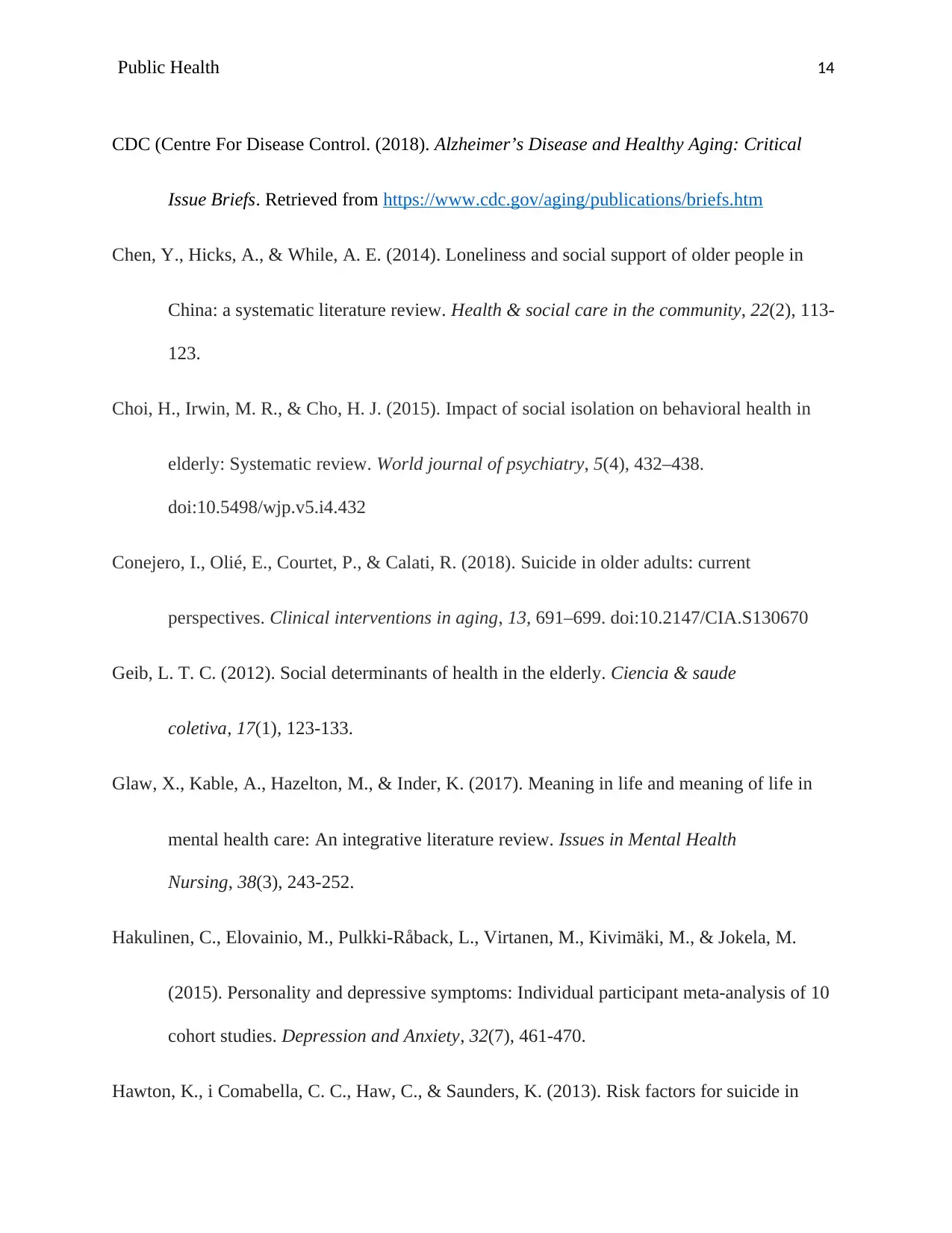
Public Health 14
CDC (Centre For Disease Control. (2018). Alzheimer’s Disease and Healthy Aging: Critical
Issue Briefs. Retrieved from https://www.cdc.gov/aging/publications/briefs.htm
Chen, Y., Hicks, A., & While, A. E. (2014). Loneliness and social support of older people in
China: a systematic literature review. Health & social care in the community, 22(2), 113-
123.
Choi, H., Irwin, M. R., & Cho, H. J. (2015). Impact of social isolation on behavioral health in
elderly: Systematic review. World journal of psychiatry, 5(4), 432–438.
doi:10.5498/wjp.v5.i4.432
Conejero, I., Olié, E., Courtet, P., & Calati, R. (2018). Suicide in older adults: current
perspectives. Clinical interventions in aging, 13, 691–699. doi:10.2147/CIA.S130670
Geib, L. T. C. (2012). Social determinants of health in the elderly. Ciencia & saude
coletiva, 17(1), 123-133.
Glaw, X., Kable, A., Hazelton, M., & Inder, K. (2017). Meaning in life and meaning of life in
mental health care: An integrative literature review. Issues in Mental Health
Nursing, 38(3), 243-252.
Hakulinen, C., Elovainio, M., Pulkki‐Råback, L., Virtanen, M., Kivimäki, M., & Jokela, M.
(2015). Personality and depressive symptoms: Individual participant meta‐analysis of 10
cohort studies. Depression and Anxiety, 32(7), 461-470.
Hawton, K., i Comabella, C. C., Haw, C., & Saunders, K. (2013). Risk factors for suicide in
CDC (Centre For Disease Control. (2018). Alzheimer’s Disease and Healthy Aging: Critical
Issue Briefs. Retrieved from https://www.cdc.gov/aging/publications/briefs.htm
Chen, Y., Hicks, A., & While, A. E. (2014). Loneliness and social support of older people in
China: a systematic literature review. Health & social care in the community, 22(2), 113-
123.
Choi, H., Irwin, M. R., & Cho, H. J. (2015). Impact of social isolation on behavioral health in
elderly: Systematic review. World journal of psychiatry, 5(4), 432–438.
doi:10.5498/wjp.v5.i4.432
Conejero, I., Olié, E., Courtet, P., & Calati, R. (2018). Suicide in older adults: current
perspectives. Clinical interventions in aging, 13, 691–699. doi:10.2147/CIA.S130670
Geib, L. T. C. (2012). Social determinants of health in the elderly. Ciencia & saude
coletiva, 17(1), 123-133.
Glaw, X., Kable, A., Hazelton, M., & Inder, K. (2017). Meaning in life and meaning of life in
mental health care: An integrative literature review. Issues in Mental Health
Nursing, 38(3), 243-252.
Hakulinen, C., Elovainio, M., Pulkki‐Råback, L., Virtanen, M., Kivimäki, M., & Jokela, M.
(2015). Personality and depressive symptoms: Individual participant meta‐analysis of 10
cohort studies. Depression and Anxiety, 32(7), 461-470.
Hawton, K., i Comabella, C. C., Haw, C., & Saunders, K. (2013). Risk factors for suicide in

Public Health 15
individuals with depression: a systematic review. Journal of affective disorders, 147(1-3),
17-28.
Heckman, J. J., & Mosso, S. (2014). The economics of human development and social
mobility. Annu. Rev. Econ., 6(1), 689-733.
Koorevaar, A. M. L., Comijs, H. C., Dhondt, A. D. F., Van Marwijk, H. W. J., Van Der Mast, R.
C., Naarding, P., ... & Stek, M. L. (2013). Big Five personality and depression diagnosis,
severity and age of onset in older adults. Journal of affective disorders, 151(1), 178-185.
Kvamme, J. M., Olsen, J. A., Florholmen, J., & Jacobsen, B. K. (2011). Risk of malnutrition and
health-related quality of life in community-living elderly men and women: The Tromsø
study. Quality of Life Research, 20(4), 575-582.
Lee, M. S. (2012). Nutritional risk, perceived health status, and depression of the young-old and
the old-old in low-income elderly women. Journal of agricultural medicine and
community health, 37(1), 12-22.
Lim, G. Y., Tam, W. W., Lu, Y., Ho, C. S., Zhang, M. W., & Ho, R. C. (2018). Prevalence of
Depression in the Community from 30 Countries between 1994 and 2014. Scientific
reports, 8(1), 2861-2867.
Nicholson, N. R. (2012). A review of social isolation: an important but underassessed condition
in older adults. The journal of primary prevention, 33(2-3), 137-152.
Peerenboom, L., Collard, R. M., Naarding, P., & Comijs, H. C. (2015). The association between
individuals with depression: a systematic review. Journal of affective disorders, 147(1-3),
17-28.
Heckman, J. J., & Mosso, S. (2014). The economics of human development and social
mobility. Annu. Rev. Econ., 6(1), 689-733.
Koorevaar, A. M. L., Comijs, H. C., Dhondt, A. D. F., Van Marwijk, H. W. J., Van Der Mast, R.
C., Naarding, P., ... & Stek, M. L. (2013). Big Five personality and depression diagnosis,
severity and age of onset in older adults. Journal of affective disorders, 151(1), 178-185.
Kvamme, J. M., Olsen, J. A., Florholmen, J., & Jacobsen, B. K. (2011). Risk of malnutrition and
health-related quality of life in community-living elderly men and women: The Tromsø
study. Quality of Life Research, 20(4), 575-582.
Lee, M. S. (2012). Nutritional risk, perceived health status, and depression of the young-old and
the old-old in low-income elderly women. Journal of agricultural medicine and
community health, 37(1), 12-22.
Lim, G. Y., Tam, W. W., Lu, Y., Ho, C. S., Zhang, M. W., & Ho, R. C. (2018). Prevalence of
Depression in the Community from 30 Countries between 1994 and 2014. Scientific
reports, 8(1), 2861-2867.
Nicholson, N. R. (2012). A review of social isolation: an important but underassessed condition
in older adults. The journal of primary prevention, 33(2-3), 137-152.
Peerenboom, L., Collard, R. M., Naarding, P., & Comijs, H. C. (2015). The association between

Public Health 16
depression and emotional and social loneliness in older persons and the influence of
social support, cognitive functioning and personality: A cross-sectional study. Journal of
affective disorders, 182, 26-31.
Pickett, K. E., & Wilkinson, R. G. (2015). Income inequality and health: a causal review. Social
science & medicine, 128, 316-326.
Sivertsen, H., Bjørkløf, G. H., Engedal, K., Selbæk, G., & Helvik, A. S. (2015). Depression and
quality of life in older persons: a review. Dementia and Geriatric Cognitive
Disorders, 40(5-6), 311-339.
Taylor, W. D. (2014). Depression in the elderly. New England journal of medicine, 371(13),
1228-1236.
Vafaei, Z., Mokhtari, H., Sadooghi, Z., Meamar, R., Chitsaz, A., & Moeini, M. (2013).
Malnutrition is associated with depression in rural elderly population. Journal of
research in medical sciences : the official journal of Isfahan University of Medical
Sciences, 18(Suppl 1), S15–S19.
WHO (World Health Organization). (2017). Mental Health of Older Adults. Retrieved from
https://www.who.int/news-room/fact-sheets/detail/mental-health-of-older-adults
depression and emotional and social loneliness in older persons and the influence of
social support, cognitive functioning and personality: A cross-sectional study. Journal of
affective disorders, 182, 26-31.
Pickett, K. E., & Wilkinson, R. G. (2015). Income inequality and health: a causal review. Social
science & medicine, 128, 316-326.
Sivertsen, H., Bjørkløf, G. H., Engedal, K., Selbæk, G., & Helvik, A. S. (2015). Depression and
quality of life in older persons: a review. Dementia and Geriatric Cognitive
Disorders, 40(5-6), 311-339.
Taylor, W. D. (2014). Depression in the elderly. New England journal of medicine, 371(13),
1228-1236.
Vafaei, Z., Mokhtari, H., Sadooghi, Z., Meamar, R., Chitsaz, A., & Moeini, M. (2013).
Malnutrition is associated with depression in rural elderly population. Journal of
research in medical sciences : the official journal of Isfahan University of Medical
Sciences, 18(Suppl 1), S15–S19.
WHO (World Health Organization). (2017). Mental Health of Older Adults. Retrieved from
https://www.who.int/news-room/fact-sheets/detail/mental-health-of-older-adults
1 out of 16
Related Documents
Your All-in-One AI-Powered Toolkit for Academic Success.
+13062052269
info@desklib.com
Available 24*7 on WhatsApp / Email
![[object Object]](/_next/static/media/star-bottom.7253800d.svg)
Unlock your academic potential
© 2024 | Zucol Services PVT LTD | All rights reserved.





